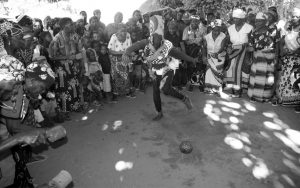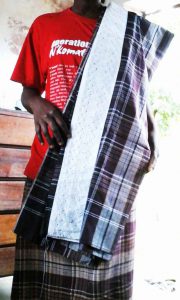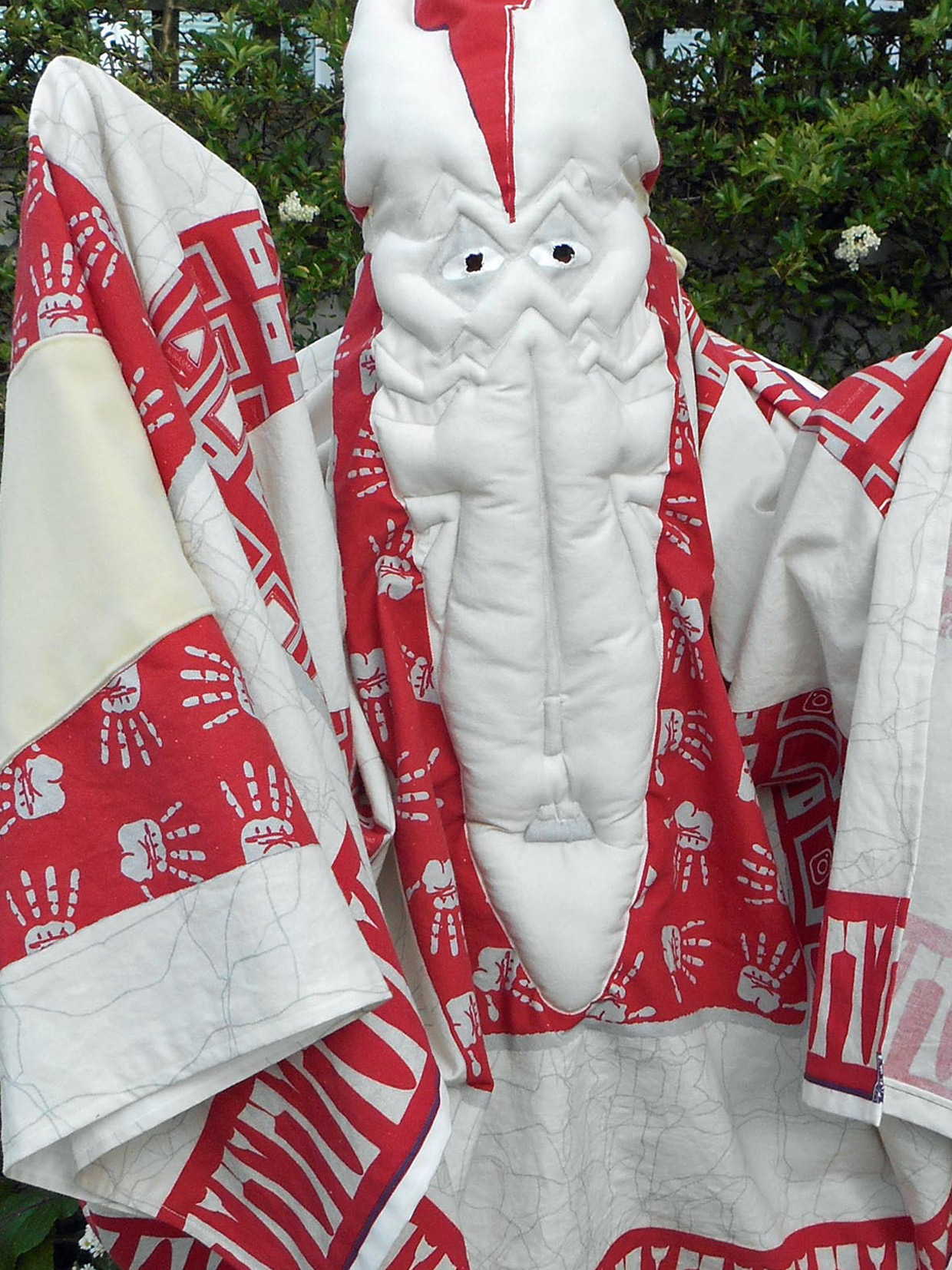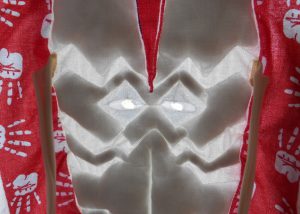This prototype print pattern features a mask that is reinforced through quilting. The design is inspired by masquerades of the Makonde people in northern Mozambique and can be donned by the user. It seeks to inspire human-material interaction that suggests the use of print fabric in alternative ways to its more recent application in mainstream global fashion.
‘Cultural Fabric Africa’ is about the potential of African print fabric to support cultural sustainability through design in the context of changing patterns of consumption.
Performance, masquerade and dance make up important expressions of traditional culture amongst many African ethnic groups. In southern Mozambique the village of Marracuene becomes a yearly place of spectacles during the Gwaza Muthini festival hosting different performers of traditional song and dance from across the country.
The Makonde people from Mozambique’s Moeda Plateau are known for their ‘Mapiko’ ritual in which men wear wooden masks to perform a public dance. The role of women used to be confined to practising a secret ritual with clay masks as part of the Mapiko ceremony. During the country’s civil war following independence from the Portuguese in 1975, women soldiers inspired by Josina Machel began to form a significant part of the freedom fighters. Fuelled by this political backdrop and a fierce national liberation struggle, some of the Makonde women began to challenge gender specific roles of the Mapiko ceremony by re-creating the dance and masquerade that was usually assigned to men. Instead of wooden masks however, they would use a roll of cloth to cover their faces and also wrap the cloth around their bodies in a way that mimicked male masquerade attire. ‘The invention spread throughout the plateau, becoming the signature dance of a generation of women empowered by the revolution.’ (Israel, 2013:205).
 Lingundumbwe Mueda, April 2009. Rui Assubuji – click image to watch video
Lingundumbwe Mueda, April 2009. Rui Assubuji – click image to watch video
On a more subtle level, Kangas of Kenya and Tanzania have taken on a performative role through the way the wearer features the proverbs printed on the cloth to communicate messages to other women. A Kanga with a specific saying could for example be worn by a woman to challenge her husbands infidelity or to warn potential female competitors. It is not the fabric in isolation, however, that effectively communicates the message but the way it is displayed. The woman wearing the cloth may walk intentionally slow and show the slogan displayed around her legs as she walks by the woman she intends to challenge.
In southern Mozambique one of the cloth designs that carries a traditional status amongst the Shangana people is of a chequered pattern similar to India n Madras cloth and Scottish Tartan. There is indeed an interesting historic connection concerning these designs which has been explored by CIAD, the Costume Institute of the African Diaspora, in a London exhibition in 2014. Originally these cloths were woven rather than printed, but are commonly perceived as Capulana along with all the other print designs and are factory produced import products. Rectangles of these cloths are sewn together with a strip of white lace (see image) and used in traditional lubolo wedding ceremonies. The mother of the bride normally dons these fabrics in a specific way with certain adornments that all become part of a performance of human-material interaction in the context of a specific cultural ritual.
n Madras cloth and Scottish Tartan. There is indeed an interesting historic connection concerning these designs which has been explored by CIAD, the Costume Institute of the African Diaspora, in a London exhibition in 2014. Originally these cloths were woven rather than printed, but are commonly perceived as Capulana along with all the other print designs and are factory produced import products. Rectangles of these cloths are sewn together with a strip of white lace (see image) and used in traditional lubolo wedding ceremonies. The mother of the bride normally dons these fabrics in a specific way with certain adornments that all become part of a performance of human-material interaction in the context of a specific cultural ritual.
Building on the concept of understanding culture as a manifestation of material in context and as a locally developed and recognized human-material interaction this prototype explores this relationship through the practice of masquerades. It aims to challenge the wearer to consider alternative uses of the cloth at a time where print fabrics are increasingly associated with their dominant use in commercial fashion trends.
To what extent does the design invite communication and/or meaningful interaction?
Rather than just facilitating conversation, this design prototype could invite direct human-material interaction. Because its visual design is used to create an active physical encounter with the cloth it may provide for a more sensual rather than intellectual communication experience.
To what extent is the design open to multiple levels of interpretation?
Because the prototype features a mask there is a certain level of implied content as it is inspired by a specific locally based practice. However, it is still open to multiple levels of interpretations as it does not imply how it is to be used. Cloth designs could also feature a variety of different motives, each one encouraging different kinds of interactions.
How accessible is it and to whom?
Such design could be used in the context of any community familiar with African print fabrics and would be accessible to all. It would not require the use of any additional tools or skills.
How could it be realised?
The design of this prototype would require an additional cloth production stage which would therefore be a proposition that would have to be taken on by a cloth producer. However, like in the ‘objects of conversation’ prototype these steps could also be resolved by designing an additional length of fabric that could feature a cut out pattern and user instructions on how to construct a fabric mask or similar designs through sewing or patchwork.
What are its limitations?
Similar to the 1st textile prototype this design would have to appeal to users both in terms of its additional functionality as well as its visual and textural qualities.


Very interesting translation from a traditional proverb to a wearable mask and a message. It’s almost like wearing a poster.